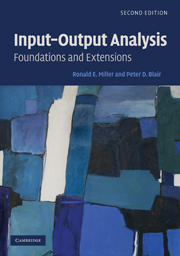Book contents
- Frontmatter
- Contents
- List of Figures
- List of Tables
- Preface
- 1 Introduction and Overview
- 2 Foundations of Input–Output Analysis
- 3 Input–Output Models at the Regional Level
- 4 Organization of Basic Data for Input–Output Models
- 5 The Commodity-by-Industry Approach in Input–Output Models
- 6 Multipliers in the Input–Output Model
- 7 Nonsurvey and Partial-Survey Methods: Fundamentals
- 8 Nonsurvey and Partial-Survey Methods: Extensions
- 9 Energy Input–Output Analysis
- 10 Environmental Input–Output Analysis
- 11 Social Accounting Matrices
- 12 Supply-Side Models, Linkages, and Important Coefficients
- 13 Structural Decomposition, Mixed and Dynamic Models
- 14 Additional Topics
- Appendix A Matrix Algebra for Input–Output Models
- Appendix B Reference Input–Output Tables for the United States (1919–2006)
- Appendix C Historical Notes on the Development of Leontief's Input–Output Analysis
- Author Index
- Subject Index
13 - Structural Decomposition, Mixed and Dynamic Models
Published online by Cambridge University Press: 05 June 2012
- Frontmatter
- Contents
- List of Figures
- List of Tables
- Preface
- 1 Introduction and Overview
- 2 Foundations of Input–Output Analysis
- 3 Input–Output Models at the Regional Level
- 4 Organization of Basic Data for Input–Output Models
- 5 The Commodity-by-Industry Approach in Input–Output Models
- 6 Multipliers in the Input–Output Model
- 7 Nonsurvey and Partial-Survey Methods: Fundamentals
- 8 Nonsurvey and Partial-Survey Methods: Extensions
- 9 Energy Input–Output Analysis
- 10 Environmental Input–Output Analysis
- 11 Social Accounting Matrices
- 12 Supply-Side Models, Linkages, and Important Coefficients
- 13 Structural Decomposition, Mixed and Dynamic Models
- 14 Additional Topics
- Appendix A Matrix Algebra for Input–Output Models
- Appendix B Reference Input–Output Tables for the United States (1919–2006)
- Appendix C Historical Notes on the Development of Leontief's Input–Output Analysis
- Author Index
- Subject Index
Summary
Structural Decomposition Analysis
When there are two or more sets of Input–Output data for an economy, analysts are often interested in trying to disaggregate the total amount of change in some aspect of that economy into contributions made by its various components. For example, the total change in gross outputs between two periods could be broken down into that part associated with changes in technology (as reflected, initially, in the changes in the Leontief inverse for the economy over the period) and that part related to changes in final demand over the period.
At the next level, the total change in the Leontief inverse matrix could be disaggregated into a part that is associated with changes in technology within each sector (as reflected in changes in the direct input coefficients matrix) and that part associated with changes in product mix within each sector. Similarly, the change in final demand could be further disaggregated into a part that reflects changes in the overall level of final demand and a part that captures changes in the composition of final demand. And there are numerous additional options – for example, there is no need to use only two contributing factors; changes in employment, value added, energy use, etc. may be of more economic interest than changes in gross outputs; and so on. For a general overview of this literature, see Rose and Casler (1996) or Dietzenbacher and Los (1997, 1998). Two early empirical examples of this kind of work can be found in Feldman, McClain and Palmer (1987) for the USA and Skolka (1989) for Austria.
- Type
- Chapter
- Information
- Input-Output AnalysisFoundations and Extensions, pp. 593 - 668Publisher: Cambridge University PressPrint publication year: 2009



